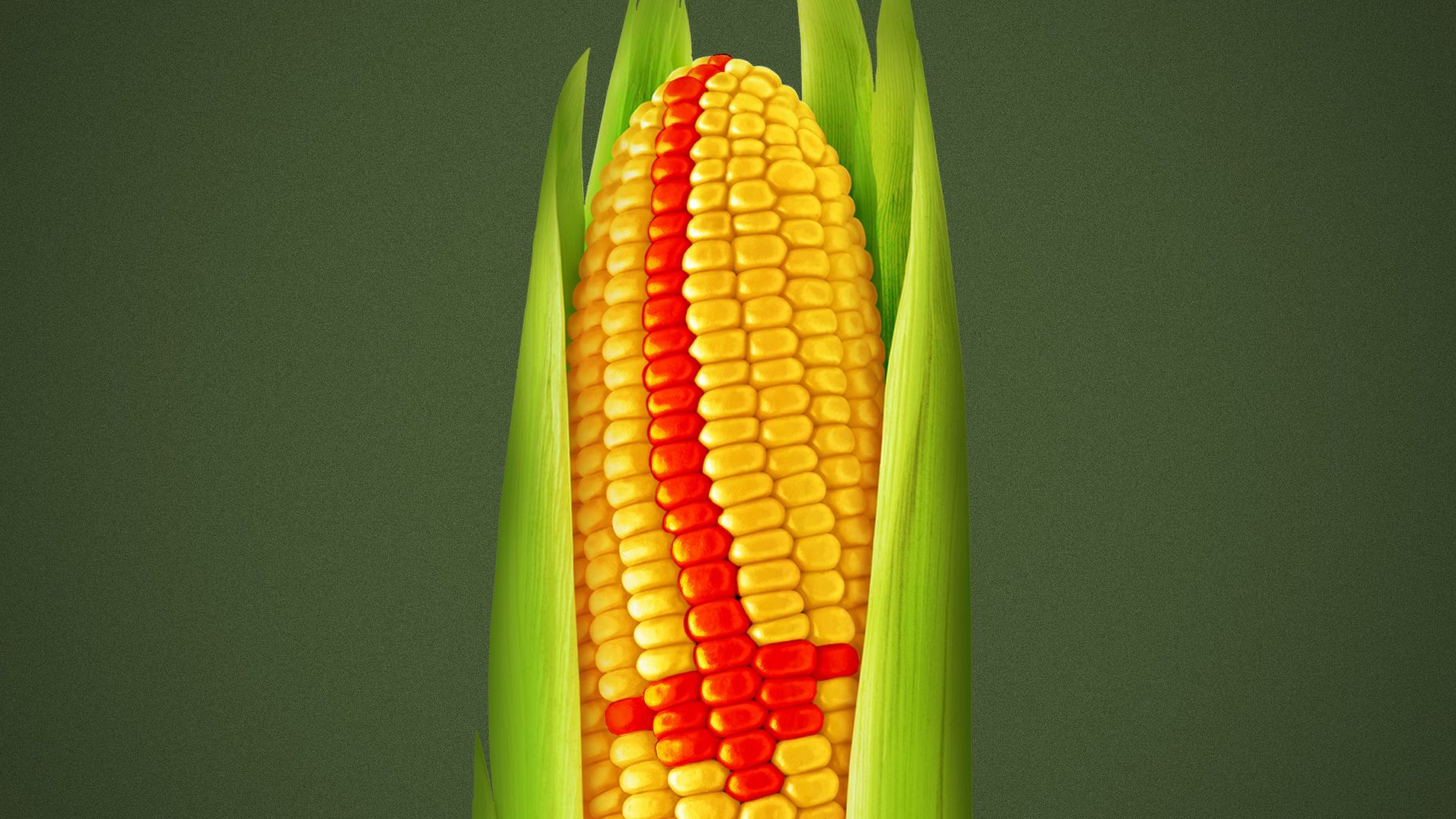
Illustration: Shoshana Gordon/Axios
Extreme weather events and our warming planet are primed to strike commodities and the food supply like never before.
Why it matters: The recent global heat wave, deadly floods across China's grain belt and wildfires that spanned several continents have put a spotlight on how climate change may wreak havoc on the world's most-consumed food crops.
The big picture: Studies show that future climate projections indicate significant reductions of crop yields in high-risk regions.
- Crop shortages may also put upward pressure on food prices, which emerged as a major source of pain for consumers during the current inflation spike, and during Russia's invasion of Ukraine.
Zoom out: Multiple economists told Axios that the long-term threat of climate change to food supply and consequences for costs of major crop commodities increasingly calls for deliberate climate mitigation and adaptation measures.
What they're saying: "The literature is pretty clear" that if the observed increased frequency of extreme weather events continues, it will hurt crop yields in particular, Roderick Rejesus, agricultural economist at North Carolina State University, told Axios.
- "It's possible we could face unprecedented market impacts if we don't do anything in terms of mitigation and adapting," Rejesus said.
State of play: Corn, wheat and rice together make up a major portion of the human diet, accounting for roughly 42% of the world's food calories.
- A 2022 Scientific Reports paper found that under global warming by 2°C (3.6°F) and relative to 1986–2005, corn yield will decrease worldwide, and increase little under global warming by 1.5 °C (2.7°F) — with the loss risk of corn by 2°C "much more serious."
Reality check: The latest UN climate change report suggests that human actions may have rendered the Paris Agreement's 1.5°C target, and possibly even its 2°C benchmark, infeasible, Axios' Andrew Freedman reported.
- The UN report also found that climate change has fueled "mostly negative" yield impacts across sub-Saharan Africa, South America, the Caribbean, southern Asia and western and southern Europe, per Carbon Brief.
How it works: When it comes to consumer prices, what we pay for the food we eat isn't only reflective of yields, but the whole supply chain.
Between the lines: Events that lead to supply chain disruptions — like the recent suspension of the Black Sea grain deal, the war in Ukraine, or severe drought in major production regions — can create volatility and uncertainty in the global market, which can increase commodity prices.
- One example: Rice production in India, the world's largest rice exporter, has been constrained by both droughts and heavy rains. On July 20, the Indian government banned exports on non-basmati white rice, which is already pushing up international prices.
- "We should be anticipating some drastic supply shocks," Seungki Lee, agricultural economist at Ohio State University, told Axios.
Zoom in: Price hikes are more imminently visible as a result of extreme weather events. But in the long run, when the contribution of recent climate trends slowing down crop yield growth compounds with lags in production growth, it can have a slow-burn effect on consumer costs, according to Cornell economist Ariel Ortiz-Bobea.
- The OECD-FAO Agricultural Outlook 2023-2032 report projects global agricultural and food production to continue to increase over the next ten years, but at a slower pace of growth than the previous decade.
- "Temperatures are higher, productivity is lower. The impacts are already here. They've already happened," said Ortiz-Bobea.
Of note: Don’t forget the developing El Niño, which layers onto the impacts of climate change, and can have highly varying effects on yields.
- A July report by Capital Economics projected that, when compared to soybeans and corn, global harvests of rice and wheat are the most at-risk during this El Niño.
Meanwhile, efforts to develop climate-resilient varieties of major crops are among leading adaptation measures pursued across the public and private sector.
Yes, but: Some experts, like Ortiz-Bobea, are skeptical of claims that U.S. agriculture is becoming more climate-resilient.
- "With all the lip service that people are giving [development of drought-tolerant crops], I don't see it in the data," said Ortiz-Bobea, who led a 2021 study showing that global farming productivity is 21% lower than it would be without climate change.
Other emerging solutions include an increasing reliance on less-familiar crops that require less water — like sorghum, an ancient grain with drought-tolerant properties, Civil Eats reported.
The intrigue: Sorghum could be a promising alternative to some major crops. But it, along with grower incentives, has received much less research attention — and that must change, according to Corey Lesk, a Dartmouth College climate scientist and research associate.
- He noted the same goes for other crops more popular in developing countries, like millet and cassava.
The bottom line: "It's pretty much every summer now that a record-breaking heatwave is happening, not just in one breadbasket, but multiple breadbaskets around the world," Lesk said. "We are currently heading into a climate regime that we have never seen before."
